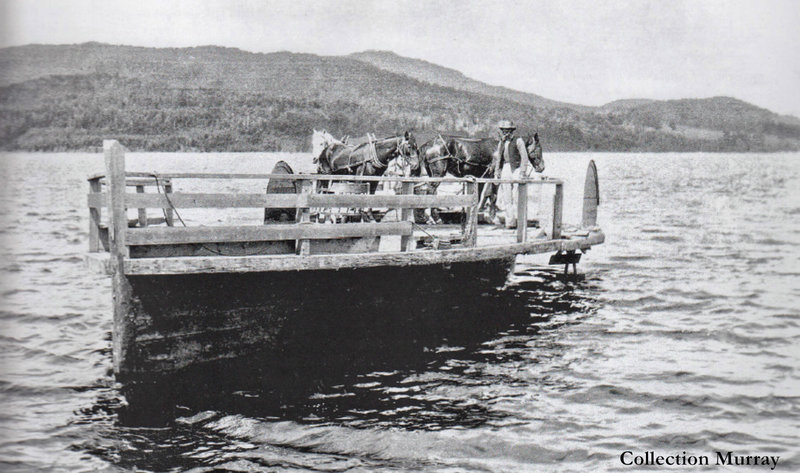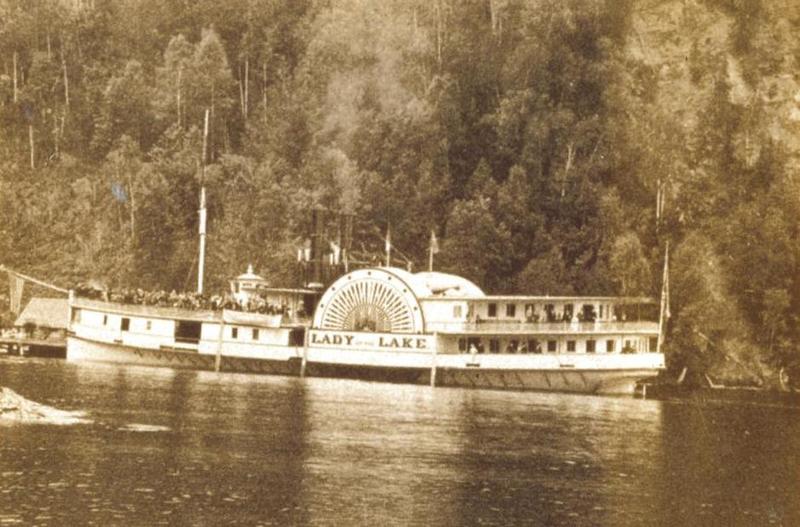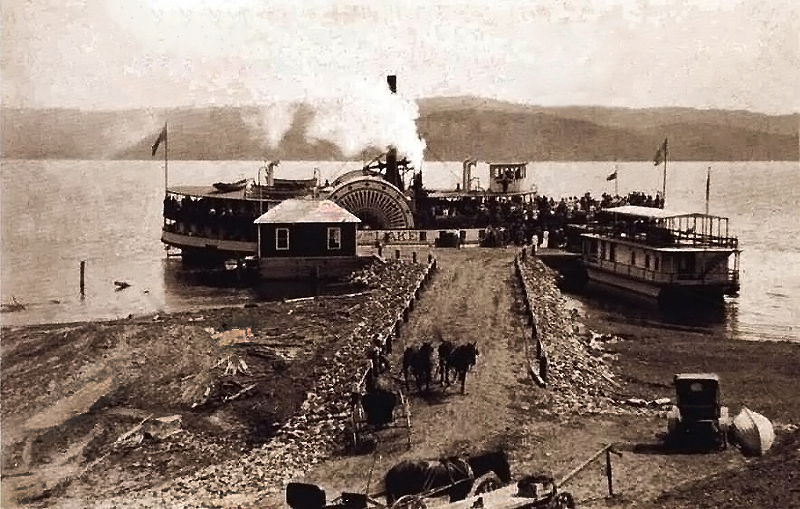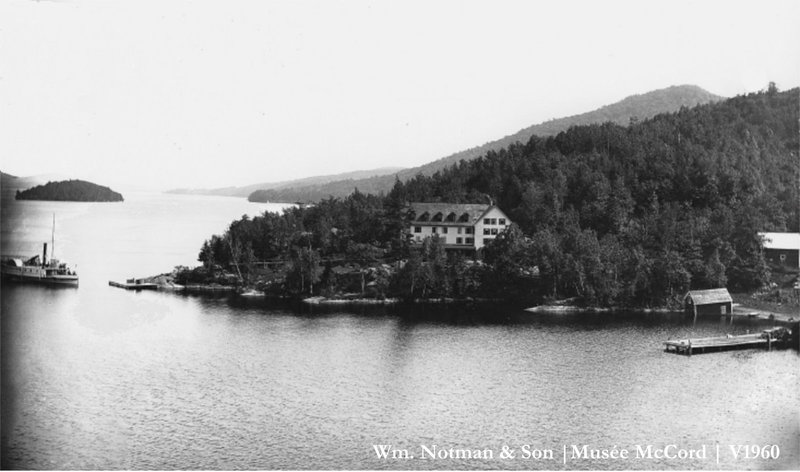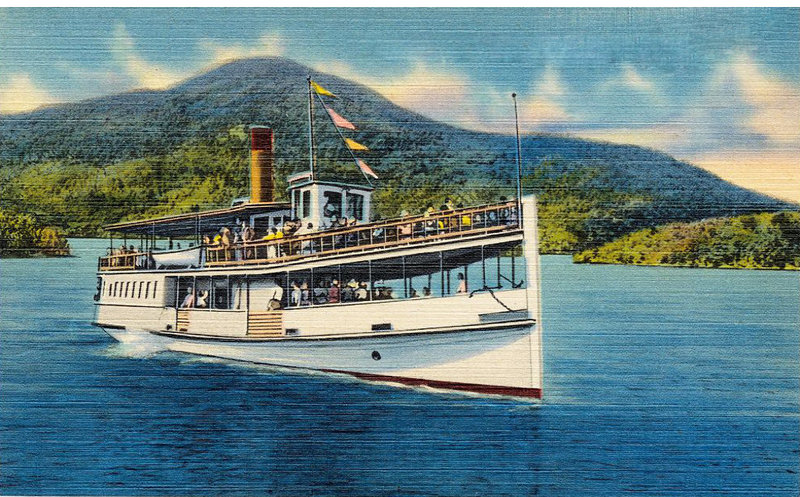Transports | Bateaux
Le lac Memphrémagog joua un rôle prédominant dans l’histoire économique pour toutes ses régions riveraines tant au Canada qu'aux États-Unis. Bien qu'à l’intérieur du continent, le canton de Potton a vécu une riche histoire de navigation. Avec les chemins de fer, le lac et ses bateaux assuraient les moyens de transport les plus fiables et les plus confortables, vu l’état incertain des premiers chemins.
Dès 1797, Moses Copps le fondateur de Georgeville inaugurait un service de traversier entre son village qui s'appelait alors Copps Ferry et Knowlton's Landing pour transporter les voyageurs de diligence entre Boston et Montréal via la passe Bolton. Sur une carte de Hiram Corey (1845), on y indique l’existence d'un «traversier à cheval» où les chevaux marchaient sur un plancher circulaire actionnant une roue à aubes. Durant l’hiver, un chemin sur la glace assurait la communication entre les deux rives.
Lake Memphremagog played a predominant economical role for all the Canadian and American communities along its shores. Despite being in the interior, Potton Township has an interesting shipping history. Together with the railways, the lake ferries provided the most reliable means of transportation given the uncertain conditions of the early roads.
As soon as 1797, Moses Copps, the founder of Georgeville, inaugurated a ferry service between his settlement, then known as Copps' Ferry, and Knowlton's Landing to service the stage-coach passengers travelling between Boston and Montreal via the Bolton Pass. A map by Hiram Corey (1845) mentions a "horse boat ferry" where three horses worked a treadmill that drove paddle wheels (Mackenzie, 1996). In winter, an ice bridge ensured travel between the two shores.
De nombreux bateaux à vapeur ont sillonné les eaux du lac Memphrémagog. Mentionnons les principaux: Le Mountain Maid (1850-1892) un vapeur à roue à aubes. Le Lady of the Lake (1867-1917), un vapeur à deux roues à aubes, devint célèbre. C'est Sir Hugh Allan qui le fit construire en Écosse. Le bateau traversa l’Atlantique en pièces détachées qui furent d'abord livrées au port de Montréal, puis à Sherbrooke par chemin de fer et enfin par voitures à cheval jusqu’à Magog où il fut assemblé et lancé en 1867.
Ce bateau assura un service de traversier entre Magog et Newport au Vermont avec des points d'arrêt sur les deux rives du lac. Il fut en service durant cinquante ans, soit jusqu'en 1917.
Later, several steamboats sailed the waters of Lake Memphremagog and the most important ones were: the Mountain Maid (1850-1892) a steamer with one paddle wheel, the Lady of the Lake (1867-1917), a steamer with two paddle wheels acquired celebrity. Sir Hugh Allan had it built in Scotland. It was shipped in parts to Montreal, transported by railroad to Sherbrooke and then by wagons to Magog where she was reassembled and launched in 1867.
The Lady of the Lake provided a ferry service between Magog and Newport with a number of stopping places on both shores. In Potton, she docked at Knowlton's Landing, Château Ruisseau, Vale Perkins and at the foot of Owl's Head for the Mountain House vacationers. She sailed for 50 years before retiring in 1917.
D'autres bateaux ont aussi assuré le transport, soit commercial soit de plaisance.
Ce sont le Minnie (1877-1881), un catamaran à vapeur à roue à aubes, et le Nora, le seul qui aurait coulé dans le lac. L’Anthemis, un vapeur à hélice, fut en service de 1909 à 1954 (Communication personnelle de Jacques Boisvert). Enfin, Hildteth (1905) illustre deux autres bateaux: le vapeur Yioco et la vedette "à gazoline" Island Queen. Dans Potton, selon Hildreth (1905), il y eut quatre débarcadères: Knowlton's Landing, Ruisseau Château où il y avait un phare, Vale Perkins et à l’hôtel Mountain House (au pied du mont Owl's Head.
During this period other boats also provided service either for business or pleasure.
They were the Minnie (1877-1881) a catamaran steamer with one paddle wheel and the Nora the only one which supposedly sank in the lake. Finally, the Anthemis, a propeller driven steamer competed with the Lady of the Lake for some time sailing from 1909 to 1954 (Jacques Boisvert, 1997, personal communication). Two other boats are shown in Hildreth (1905): the steamer Yioco and the "gasolene" launch Island Queen.
